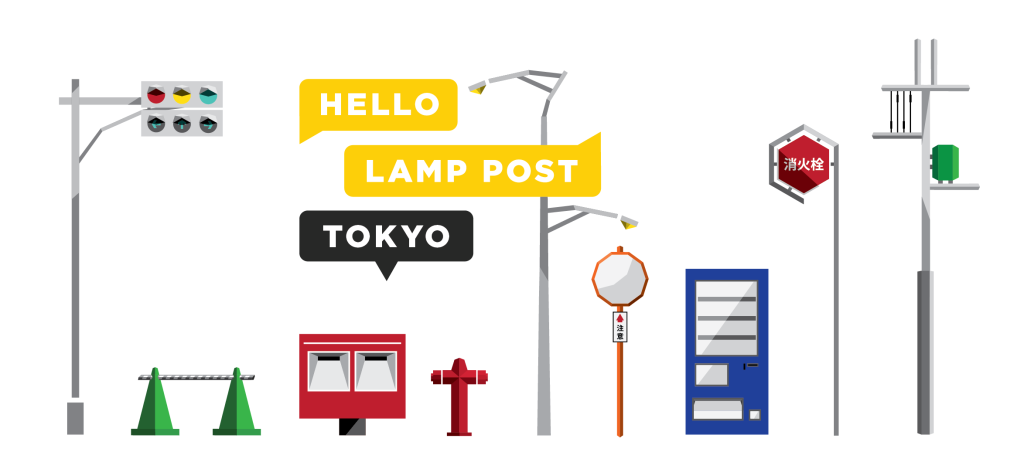Hello Lamp Post Tokyo

Ben Barker
20th April 2015
Next weekend our playful city-wide project Hello Lamp Post will move from Austin, where it has been running for the last two months, to Tokyo where it will launch at Roppongi Art Night. From Saturday using text messaging on their mobile phones Tokyoites will be able to talk to the famous outdoor vending machines, street mirrors and any other city object with a serial code. As the objects wake up, they will learn from Tokyo’s inhabitants and share back the stories they hear. The project is being produced by British Council and was first developed for Watershed’s Playable City Award 2013.
Whilst Austin is young, spacious and built on its small town image, Tokyo is a venerable giant that spent the 20th century defining the idea of a modern metropolis. Both are changing fast though, Austin through it’s booming technology sector and Tokyo, under Shinzo Abe’s pro outsider policies, by learning to encourage a more diverse business and cultural outlook to boost the slowing economy. Like Austin, Tokyo has one of the most digitally literate populations in the world, it’s an exciting step for Hello Lamp Post.
Culturally Tokyo is also the city where cuteness, or Kawaii, is an acknowledged cultural product, Hello Kitty being Catmander in Chief. Aside from the similarities in name, charming is a word we’ve often used to describe the interaction at the core of Hello Lamp Post, that of helping newly sentient objects to understand the city they find themselves in. We hope that bodes well for the appeal of the project, though we’re aware we may be preaching to the choir when it comes to using technology to bring play and charm to public space.
So while we prepare for Tokyo this week, it’s also the last chance to play Hello Lamp Post in Austin, it will leave the city on the 27 April after having already received over 20,000 messages from Austin’s weird and curious denizens. As it draws to a close we wanted to reflect a little on how people are playing (click on the images to enlarge). We started off looking at some of the language used, what gets talked about and how does it compare against it’s antonyms?
This next map looks at bus stops in the city to see where people have been playing. Something we were really keen to do in Austin was to take the project to each of the newly formed 10 districts. As the map shows, we found the same thing as with the postboxes in Bristol, there is actually a really great spread of play. One of the things we are most proud of about Hello Lamp Post, is that it brings public art to people outside of the normal downtown bubble.
Finally, just to prove it is sometimes cold in Austin, a graph of when people play by temperature. This was taken four weeks in, so has probably warmed up, but there was even an icy patch in early spring.
We’ll take a lot of that forward into Tokyo. It’s such a big city we can’t try to promote the project everywhere, as in Austin, but we can animate some exciting objects. As ever, you can talk to anything in the city, but we’re particularly excited about Louise Bourgeois Maman being given a voice, as well as the height competitive Mori and Tokyo Towers. We’ll be promoting these from a couple of different vantage points. Tokyo Tower is a large, Eiffel inspired lattice tower and hopefully its scale will work to our advantage with people able to see it from most of the city.
The system has also now learnt Japanese and in so doing become bilingual. Now if you say “こんにちは 六本木 交差点 #106” then it will recognise you as a native and reply accordingly, and if you speak in English then it will reply in English. We’ve also had to overcome a few regional issues, not least embrace email as a mechanism rather than SMS. Due to the fact mobile data was available here much earlier than in the west, SMS technology was largely bypassed and the dominant cross network system became email, with networks providing a phone specific address with any sim-card. So culturally email is treated more like sms, meaning it works on all phones smart or dumb and will work in either the messaging clients or email ones.
Finally of course we found that language just isn’t that simple. Japanese has a subject-object-verb structure, unlike English. Therefore the system needs to reflect that in the way it constructs a response. This means objects have to think differently about English responses “Another person told me something” than Japanese ones where it becomes “Another person something me told”. What a fun way of exploring different cultures this project is.
There’s lots more to share about our adventures with Hello Lamp Post over the last 18 months, but for now it’s just to say a huge thank you to Austin for being such a perfect match for the system, and to Tokyo for inviting this weird little project to cross the pacific. You can learn more about Austin here or Tokyo here and if you are interested in bringing Hello Lamp Post to your city, then please do get in touch here.



